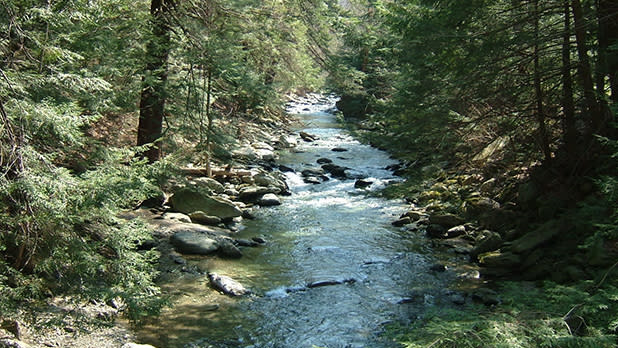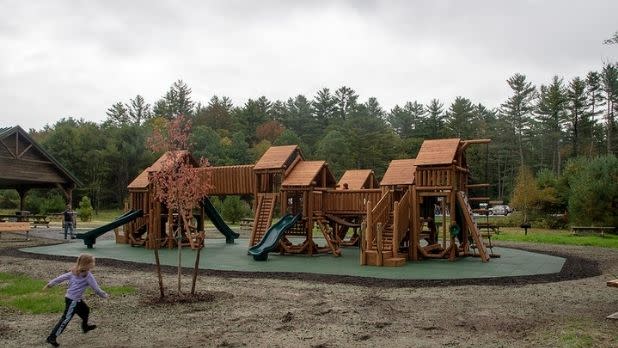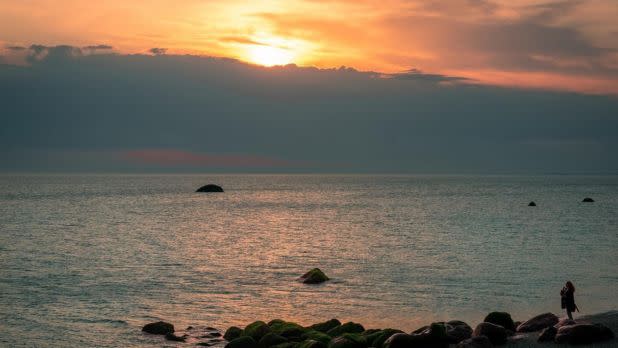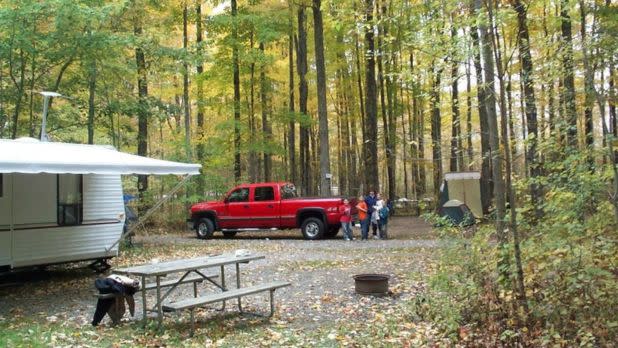
Credit: @pobz_iv on Instagram
Camping is one of the best and most affordable family vacations, immersing you in the peace and tranquility of nature. With warmer weather on the horizon, make reservations at one of New York State’s great campgrounds and plan a stay in the great outdoors. State parks and campgrounds abound, from glittering Lake George to thundering Niagara Falls. New York State also has a variety of privately-owned campgrounds perfect for all your needs, from full-service resorts to more rustic family-friendly places. If you aren’t quite into roughing it in the wilderness, try glamping, which elevates sleeping in the great outdoors with creature comforts and modern conveniences. Whether you like to rough it, follow historic pathways, or live luxuriously, New York camps offer something for everyone to love.
Originally published: 03/02/2021
North-South Lake State Campground (Catskills)

When it comes to scenic camping destinations, the Catskills are a sure bet. North-South Lake State Campground, with more than 200 camping sites, offers numerous opportunities to take in scenic vistas. Hike one of the many trails inside the park, including one leading to the former site of Catskill Mountain House, for sweeping views of the Catskill Mountains and Hudson River. Or kayak, rowboat, canoe, or paddleboard across the expansive lake. Located in the northeast corner of Catskill Park, North-South Lake campground is the most popular lakeside campground in New York State.
Allegany State Park (Chautauqua-Allegheny)

With over 65,000 acres, Allegany State Park is the largest state park in New York State. The park is divided into two areas, the Red House Area and the Quaker Area. Both offer camping, with the Red House area’s 125 campsites and 144 cabins perfect for anything from a weekend retreat to an extended vacation. Campers at the Quaker Area will find two lakes, a sandy beach for swimming, two fishing piers, and a canoeing or kayaking access point. Best of all, both areas are only 40 minutes away from the National Comedy Center and Rock City Park, for great day trips as part of a stay.
North Fork Cottages & RV Resort (Long Island)

Credit: Courtesy of East Long Island Kampground
The North Fork Cottages & RV Resort is the largest privately owned campground on Long Island and offers a mix of RV, yurt, luxury safari tent, and cottages. The campground is minutes from downtown Greenport, ocean and Long Island Sound beaches, and several North Fork wineries and breweries. The resort’s on-site amenities and activities include pickleball courts, basketball court, pool, rec center, and playground.
Robert H. Treman State Park (Finger Lakes)

Robert H. Treman State Park is an area of wild beauty, with the rugged Enfield Glen gorge as its scenic highlight. Winding trails follow the gorge past 12 waterfalls, including the 115-foot Lucifer Falls, where visitors can see a mile-and-a-half down the wooded gorge as it winds its way to the lower park. Campers can choose from tent or RV sites or cabins, and enjoy nine miles of hiking trails, or swim in a stream-fed pool beneath a roaring waterfall. A maximum of two pets are allowed per campsite, with restrictions.
Herkimer Diamond Mine and KOA (Central New York)

At Herkimer Diamond Mine and KOA, you can sift for diamonds (quartz crystals) that are close to 500 million years old! From deluxe RV and tent sites to luxury lodges (the Astronomy Lodge has its own private elevated observatory with a high-powered telescope) to camping cabins and glamping pods, you’ll find the perfect location for your camping vacation at this beautiful facility bordering the West Canada Creek. Enjoy world-class trout fishing, tubing, and other recreational activities right on the property; stay in a tree house lodge or a solar-powered cabin; and take a swim in the sparkling diamond pool. Pets are welcome.
Wellesley Island State Park (Thousand Islands-Seaway)

If you love fishing, combine the legendary angling of the Thousand Islands-Seaway region with the joy of camping at Wellesley Island State Park, the largest camping complex in the region, with 432 campsites. The fishing is excellent, particularly for perch, smallmouth bass, pike, and muskie, and there is a full-service marina and four boat launches. Find tent and RV sites, cabins, or rent a fully outfitted cottage with showers, kitchen utensils, and more. While you’re on the island, visit the Minna Anthony Common Nature Center to see its nature exhibits and seasonal butterfly house. Swimmers and sunbathers enjoy the sandy beach on the river (pictured), and the campground also features a camp store, laundromat, arcade, and the 9-hole Wellesley Island State Park Golf Course.
Collective Retreats (New York City)

Credit: @collectiveretreats on Instagram
Revel in the joy of glamping in one of the most unexpected and delightful places—Governors Island! You’ll depart from the hustle and bustle of Manhattan in a complimentary private water taxi and land on the lush green shores of the island, where you’ll enjoy incredible views of the Manhattan skyline. Three types of accommodations are available. The Summit Tent and the Outlook Shelter are both more private, with bathrooms, a luxury spa soaking tub, and a king bed. The Journey Tents are part of a more communal experience. They’re spaced slightly closer together and share a bathroom but are still elegant and comfortable. No matter where you sleep, enjoy fresh complimentary private in-tent continental breakfast and a one-of-a-kind view of the Statue of Liberty across New York Harbor.
Cherry Hill Campground (Greater Niagara)

Hey, tenters and pop-up campers, here’s a campground for you! Located across the street from Six Flags Darien Lake, Cherry Hill Campground offers 50 large spacious sites, lean-to cabins for rent, internet access, and clean restrooms with hot showers. They also have a camp store for drinks, snacks, gifts, and camping supplies, and each site has a picnic table and fire ring.
Taconic State Park, Copake Falls Area (Hudson Valley)

Whether you’re in the mood for a more rustic camping experience or seeking a more "home-like" experience, Taconic State Park’s Copake Falls Area has a perfect option for you. Between tent sites, tent platforms, and trailer sites, the park has around 100 campsite options,as well as cabins with electricity, lights, hot and cold running water, a kitchen with a refrigerator and stove, a dining area, a picnic table, and outdoor campfire ring with a grill.
Frontier Town Campground, Equestrian and Day Use Area (Adirondacks)

Built on the site of the storied former Frontier Town theme park, this campground is a tribute to the Adirondacks’ legacy and a symbol of its continued revitalization. In addition to 77 equestrian, RV/trailer, and tent camping areas along the Schroon River, this one-of-a-kind, family-friendly recreational spot offers a wide range of amenities including a pavilion, playgrounds, electric vehicle charging stations, and a comfort station, as well as ADA-compliant pedestrian trails, facilities, and picnic/fireplace areas.
Schodack Island State Park (Capital-Saratoga)

Spanning 1,052 acres and portions of Rensselaer, Greene, and Columbia counties, Schodack Island State Park is located between the Hudson River and Schodack Creek. The park boasts 66 campsites and many activities and amenities, including biking, boating (launches available), canoeing/kayaking, fishing, hiking, hunting, playgrounds, and playing fields.
Wildwood State Park (Long Island)

Credit: @jay.hake on Instagram
Looking for stunning sunsets and epic stargazing? Long Island’s Wildwood State Park, nestled on 600 acres of undeveloped hardwood forest overlooking the Long Island Sound, is the perfect setting to unwind and enjoy the simpler joys of life with 314 tent and RV sites plus 10 cozy cottages (3 of which are accessible) tucked amid the trees. Two miles of beach lets you spend the day fishing and swimming in the cool waters of the Sound. Then, if you’re not too tuckered out, you can spend your night watching movies under the stars or square and line dancing.
Crystal Grove Diamond Mine and Campground (Central New York)

Can you dig it? Yes, you can at Crystal Grove Diamond Mine and Campground in St. Johnsville. Spend the day unearthing Herkimer diamonds, and then walk across a footbridge to your campsite to polish those gems by firelight. Their pet-friendly accommodations boast beautiful campsites with picnic tables and fire rings as well as rustic cabins with porches perfect for lounging.
For more information on booking a stay at a campground or glamping site, please visit Camping and Glamping in New York. Please visit NYS Parks, the Department of Environmental Conservation's camping page, and Camp New York for additional campground and reservation information.
Don't forget to post photos of your New York adventures on Instagram and Twitter with #iSpyNY and tag us on Facebook!
 NEWSLETTER
NEWSLETTER
